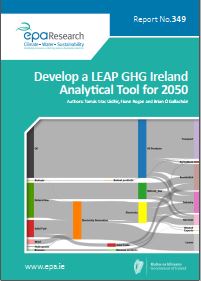Research 349: Develop a LEAP GHG Ireland Analytical Tool for 2050
Authors: Tomás Mac Uidhir, Fionn Rogan and Brian Ó Gallachóir
Summary: This report describes a greenhouse gas (GHG) emissions model of Ireland’s energy and agriculture sectors, which were responsible for approximately 61 million tonnes (Mt) of GHG emissions in 2017. The Low Emissions Analysis Platform (LEAP) software was used to build the LEAP Ireland 2050 model, which simulates the development of future possible decarbonisation pathways for Ireland.

Access the LEAP Ireland 2050 model: https://github.com/MaREI-EPMG/LEAP_Ireland
The LEAP Ireland 2050 model is maintained within the EPMG within UCC. The tool is hosted online and is accessible via the MaREI datahub. Access to the LEAP model is subject to a Creative Commons licence. The tool requires a licensed version of the Low Emissions Analysis Platform system software to be utilised successfully.
Identifying Pressures
This project identifies a gap in the current suite of energy and climate policy analytical tools available to policymakers in Ireland. There is a need for accessible and robust tools that can bridge the gap between analysts and decision-makers. This report highlights the need for the industry and services sectors to receive more detailed policy analysis and for the transport and residential sectors to receive a broader policy analysis, i.e. beyond private car transport and residential retrofitting. There is a need to address the challenges presented by climate change using a systemic approach that incorporates all sectors of the Irish economy, their interactions and their interdependence.
Informing Policy
Analysis of building grant support schemes in Ireland found that an output-based policy support scheme could improve energy efficiency savings in residential dwellings. During 2010–2015, residential retrofitting could have achieved an additional 86% energy savings under a different set of retrofit combinations. This report also evaluates future policy targets within the government’s climate action plan, e.g. 840,000 electric vehicles within private passenger transport by 2030. Scenario analysis highlights the challenge of sufficiently fast diffusion to achieve the electric vehicle target. If the target is met, the difference between early action and late action could be 1.2 MtCO2eq. While ambition for climate policy targets is welcome, it needs to be founded on robust, replicable analysis of feasible pathways that fully understand the challenges and present solutions.
Developing Solutions
This report presents a range of new accessible computer models and techniques that can (1) calculate greenhouse gas emissions across all economic sectors, (2) quantify greenhouse gas reduction potential and (3) identify the possible growth in energy demand and emissions in the medium to long term. A new method for developing simulation models (the Application Script Editing Tool – ASET) aided in the development of a new accessible and robust simulation energy model – LEAP Ireland 2050 – that covers all sectors of the economy. Each sector is modelled based on the best available data. The level of data granularity enables a range of diverse policy questions about the impact of different climate and energy policy measures to be considered. The user interface within the LEAP Ireland 2050 model serves as an accessible tool for policymakers for future decision-making and planning robust climate policy.
https://www.epa.ie/media/epa-2020/publications/research/Thumbnail_349.jpg